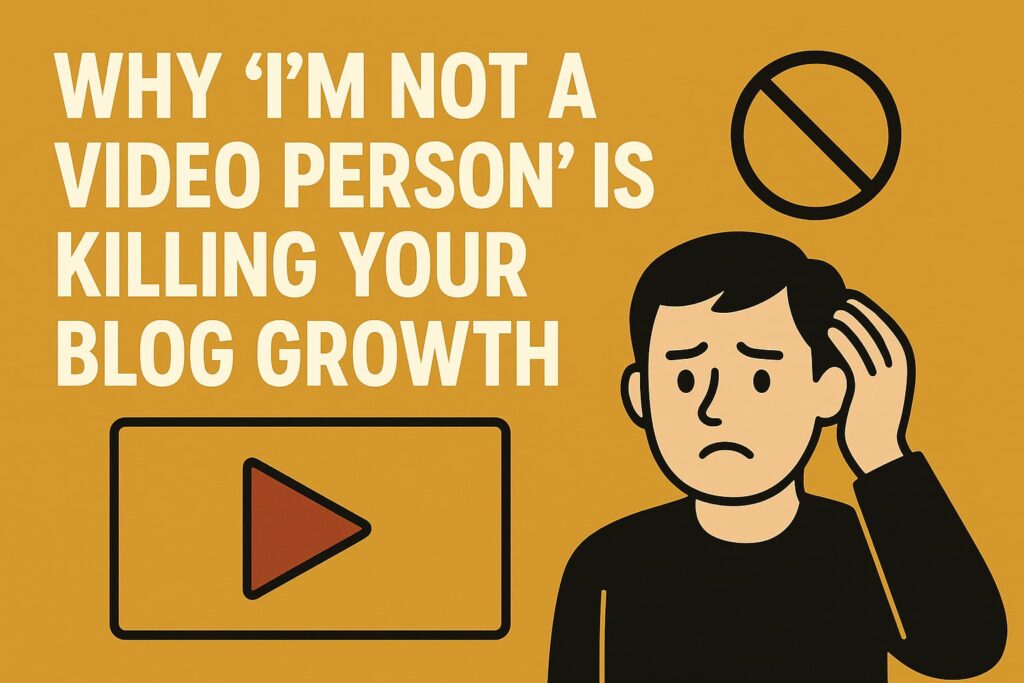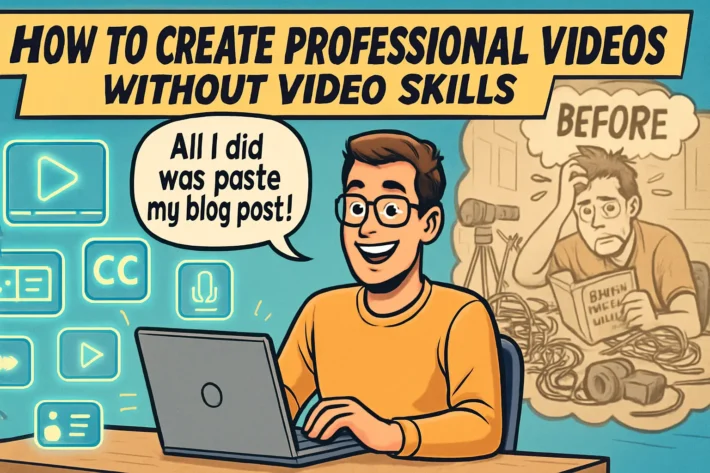Why ‘I’m Not a Video Person’ is Killing Your Blog Growth

“I’m not a video person.”
I’ve heard this phrase from countless talented writers over the past few months. Smart, articulate creators who can craft compelling 2,000-word articles that captivate readers from the first sentence to the last. Writers who’ve built loyal followings through nothing but the power of their words.
And yet, they’re watching their growth stagnate.
If you’re one of these writers – if you’ve ever uttered those five words – this post is for you. Because while you’ve been perfecting your craft in the written word, the digital landscape has shifted beneath your feet. And that shift is costing you readers, subscribers, and revenue.
The Uncomfortable Truth About Modern Content Consumption
Let’s start with some data that might make you uncomfortable:
- Video content generates 1200% more shares than text and image content combined
- 89% of businesses now use video as a marketing tool – up from 61% in 2016
- 93% of marketers say video has given them good ROI – the highest satisfaction rate of any content format
- Video posts on social media receive 48% more views than those without
But here’s the kicker for writers specifically: LinkedIn video posts receive 5 times more engagement than static posts, with video content averaging a 5.60% engagement rate compared to text posts. That’s your professional network – the people most likely to value your expertise – overwhelmingly preferring video content.
Your brilliant insights, your carefully crafted arguments, your hours of research – they’re competing for attention in a world that increasingly rewards video-first creators.
The Identity Crisis That’s Holding You Back
“But I came here to write, not to perform.”
I get it. You didn’t start your blog to become a YouTuber. You’re not trying to be the next TikTok sensation. You’re a writer. Your superpower is taking complex ideas and making them accessible through the written word.
This identity attachment isn’t just preference – it’s practical. You’ve invested years developing your writing voice. You understand your audience through comments and email replies. You’ve built systems around research, drafting, and publishing written content.
The thought of starting over with video feels like abandoning everything you’ve built.
What “I’m Not a Video Person” Really Costs You
Let me paint a picture of two hypothetical writers who started their Substack newsletters on the same day with similar content quality:
Sarah publishes excellent weekly articles but only promotes them through Substack Notes and occasional LinkedIn text posts. After 12 months, she has 500 subscribers and struggles to grow beyond her immediate network.
Michael publishes the same quality content but creates short video summaries of each article, sharing them across LinkedIn, Twitter, and Instagram. He doesn’t consider himself a “video person” either, but he found a way to repurpose his written content into video format. After 12 months, he has 2,800 subscribers and a growing email list.
Same content quality. Same writing talent. Different willingness to adapt to how audiences consume content in 2025.
The cost isn’t just about numbers – it’s about impact. Your ideas, your expertise, your unique perspective on the world – they’re reaching a fraction of the people who need to hear them.
The Platform Reality Check
Here’s what’s happening on the platforms where your audience already spends their time:
LinkedIn: The algorithm heavily favors video content. Video posts receive 5x more engagement than text posts about industry insights, while someone recording a 30-second video saying the same thing gets thousands of views.
Twitter/X: Thread engagement is declining while video tweets consistently outperform. Video tweets receive 10x more engagement than text-only tweets about the same topic.
Instagram: If you’re not creating Reels, you’re practically invisible. Reels receive 22% more engagement than regular video posts, and the platform has made it clear that video creators get priority in the algorithm.
TikTok: The fastest-growing platform for content discovery is 100% video-based. TikTok has over 1 billion monthly active users, and your target audience is there, but they’ll never find you if you’re not creating video content.
You don’t have to like this reality, but ignoring it won’t make it go away.
The Expertise Trap
There’s another layer to this problem: you’re too good at writing.
Your articles are comprehensive, well-researched, and thoroughly cover topics from multiple angles. They’re exactly what your audience needs for deep learning. But they’re also 1,500-3,000 words long, which creates a promotion problem.
How do you distill a nuanced, multi-faceted article into a compelling 60-second video? How do you capture the depth of your thinking in a format that rewards brevity and visual engagement?
Most writers try to cram everything into the video, creating overwhelming content that doesn’t work in either format. Or they create surface-level videos that don’t reflect their expertise, feeling inauthentic and promotional.
The Compound Effect of Video Avoidance
Every week you don’t create video content, you fall further behind. Here’s why:
Algorithm Momentum: Video platforms reward consistent creators. The earlier you start, the more the algorithm learns about your audience and amplifies your content.
Skill Development: Video creation is a learnable skill, but it takes time to develop. Waiting means starting from zero while others are getting better.
Audience Expectations: Your audience is increasingly expecting video content. The longer you wait, the more they assume you’re not active on video platforms.
Competitive Advantage: Right now, there’s still opportunity for thoughtful creators to stand out in video. As more writers embrace video, that opportunity diminishes.
The Mental Model Shift That Changes Everything
Here’s the reframe that successful writers have made:
Video isn’t about becoming a different person. It’s about amplifying the person you already are.
You’re not trying to become a video creator who happens to write. You’re a writer who uses video as a distribution channel for your ideas.
Think of video as a trailer for your written content, not a replacement for it. A 60-second video introducing your article’s key insight can drive hundreds of people to read your full piece.
The Path Forward (Without Losing Your Identity)
The solution isn’t to abandon writing for video. It’s to find a way to leverage your writing superpower in a video-first world.
Here’s what that looks like:
1. Start with your existing content: Your best articles already contain the insights that could become compelling videos. Don’t create new content – repurpose what you’ve already written.
2. Focus on key insights, not comprehensive coverage: A video doesn’t need to cover everything your article does. It needs to communicate one compelling idea that makes people want to read the full piece.
3. Use your writing process for video: Approach video creation like you approach writing – with research, outlining, and editing. The medium is different, but the process can be similar.
4. Let technology handle the technical stuff: You don’t need to become a video editor any more than you need to become a web developer to publish online. Focus on the message, not the mechanics.
The Cost of Waiting
Every month you delay adapting to video, you’re not just missing out on growth – you’re falling behind writers who started earlier. The creators who embrace video now will build larger audiences, stronger personal brands, and more opportunities.
Your expertise deserves a bigger platform. Your insights deserve wider reach. Your writing deserves to be discovered by people who need it.
But none of that happens if you stay invisible in a world that rewards video creators.
The Choice in Front of You
You have three options:
- Keep doing what you’re doing and accept slow, limited growth
- Try to become a video creator and struggle with a completely new skill set
- Find a way to amplify your writing through video without abandoning your core identity
The first option is safe but limiting. The second is overwhelming and often leads to burnout. The third is where the opportunity lies.
Your Next Step
If you’re ready to stop letting “I’m not a video person” limit your growth, the first step is simple: stop thinking of video as a separate skill and start thinking of it as a distribution channel for your writing.
Your words have power. Your insights have value. Your expertise deserves a bigger audience.
The question isn’t whether you’re a video person. The question is whether you’re willing to let your ideas reach the people who need them most.
The choice is yours. But the cost of not choosing is getting higher every day.
Ready to transform your blog posts into engaging videos without becoming a video creator? Discover how Nescaro can turn your articles into professional videos in minutes, not hours


